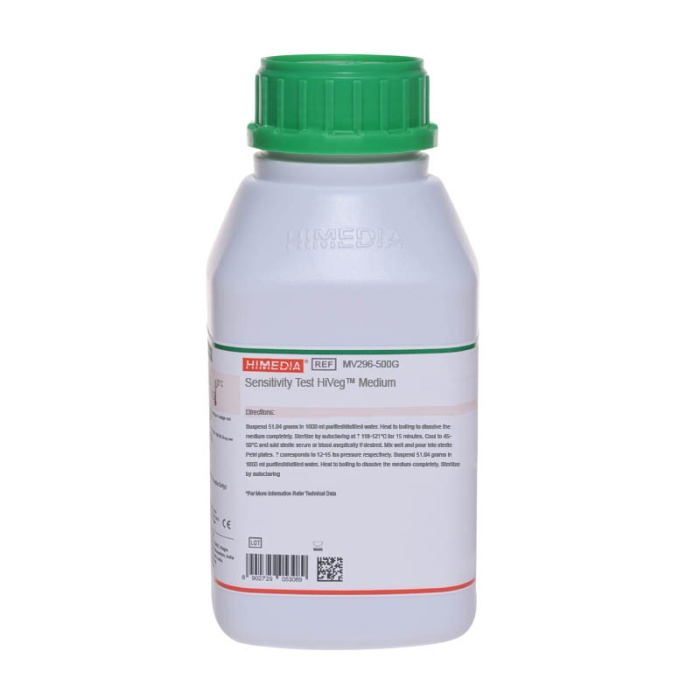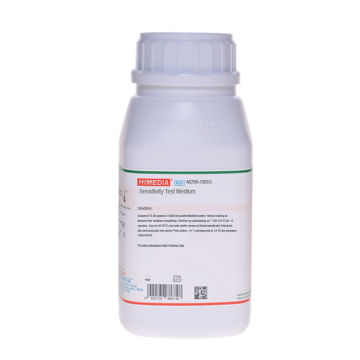 Your enquiry has been submitted
Your enquiry has been submitted
Antibiotic Sulphonamide Sensitivity Test Agar (ASS Agar)
Intended Use:
Recommended for testing the antimicrobial effectiveness of antibiotics and sulphonamides as well as for detecting the presence of antimicrobial substances in milk, urine and other fluids.
Composition**
| Ingredients | g / L |
|---|---|
| Proteose peptone | 10.000 |
| HM peptone B # | 10.000 |
| Dextrose (Glucose) | 2.000 |
| Sodium chloride | 3.000 |
| Disodium hydrogen phosphate | 2.000 |
| Sodium acetate | 1.000 |
| Adenine | 0.010 |
| Guanine | 0.010 |
| Uracil | 0.010 |
| Xanthine | 0.010 |
| Agar | 12.000 |
Final pH ( at 25°C): 7.2±0.2
**Formula adjusted, standardized to suit performance parameters
# Equivalent to Beef extract
Directions
Suspend 40.04 grams in 1000 ml purified / distilled water. Heat to boiling to dissolve the medium completely. Sterilize by autoclaving at 15 lbs pressure (121°C) for 15 minutes. Cool to 45-50°C. Mix well and pour into sterile Petri plates.
Principle And Interpretation
Ericsson and Sherris (1) on behalf of the German Institute of Standardization (2) and World Health Organization (WHO) developed an accurate quantitative method for antibiotic sensitivity testing. WHOs Expert Committee on Antibiotics have set certain requirements to be fulfilled by Sensitivity Test Agar. Antibiotic Sulphonamide Sensitivity Test Agar (ASS Agar) fulfils these criteria. This media can be used for detecting the presence of antimicrobial substances in milk, urine and other fluids as cited by Ansorg and Sogard (3,4). The presence of various amino acids makes the media favourable for growth and testing of various fastidious organisms like Listeria, Streptococci and Neisseria etc.
Proteose peptone and HM peptone B extract provides nitrogen and carbon source, long chain amino acids, vitamins and other necessary nutrients to the organisms. Glucose serves as the carbon source. Disodium hydrogen phosphate helps in maintaining the pH and preventing the effect of pH change on antibiotic diffusion. The medium constituents do not inhibit the growth of the test organism. Therefore, the zones of inhibition obtained are solely due to the antibiotic used. Standard Methods are employed for sensitivity testing.
Type of specimen
Isolated Microorganism from clinical samples, dairy samples
Specimen Collection and Handling
For clinical samples follow appropriate techniques for handling specimens as per established guidelines (5,6). For dairy samples, follow appropriate techniques for sample collection and processing as per guidelines (7,8). After use, contaminated materials must be sterilized by autoclaving before discarding.
Warning and Precautions
In Vitro diagnostic use. For professional use only. Read the label before opening the container. Wear protective gloves/protective clothing/eye protection/ face protection. Follow good microbiological lab practices while handling specimens and culture. Standard precautions as per established guidelines should be followed while handling clinical specimens. Safety guidelines may be referred in individual safety data sheets.
Limitations
1. Well isolated colonies must be used.
Performance and Evaluation
Performance of the medium is expected when used as per the direction on the label within the expiry period when stored at recommended temperature.
Quality Control
Appearance Cream to yellow homogeneous free flowing powder
Gelling Firm, comparable with 1.2% Agar gel.
Colour and Clarity of prepared medium Yellow coloured, clear to slightly opalescent gel forms in Petri plates
Reaction Reaction of 4.0% w/v aqueous solution at 25°C. pH : 7.2±0.2
pH 7.00-7.40
Cultural Response Cultural characteristics observed after an incubation at 35-37°C for 18-24 hours.
| Organism | Inoculum (CFU) | Growth | Recovery |
|---|---|---|---|
| # Bacillus spizizenii ATCC 6633 (00003*) | 50-100 | good | 50-70% |
| $ Phocaeicola vulgatus ATCC 8482 | 50-100 | good | 50-70% |
| Enterococcus faecalis ATCC 29212 (00087*) | 50-100 | good | 50-70% |
| Staphylococcus aureus subsp. aureus ATCC 25923 (00034*) | 50-100 | good | 50-70% |
| Streptococcus pyogenes ATCC 19615 | 50-100 | good | 50-70% |
Key : *Corresponding WDCM numbers. # Formerly known as Bacillus subtilis subsp. spizizenii $ Formerly known as Bacteroides vulgatus
Storage and Shelf Life
Store between 10-30°C in a tightly closed container and the prepared medium at 20-30°C. Use before expiry date on the label. On opening, product should be properly stored dry, after tightly capping the bottle in order to prevent lump formation due to the hygroscopic nature of the product. Improper storage of the product may lead to lump formation. Store in dry ventilated area protected from extremes of temperature and sources of ignition. Seal the container tightly after use. Product performance is best if used within stated expiry period.
Disposal
User must ensure safe disposal by autoclaving and/or incineration of used or unusable preparations of this product. Follow established laboratory procedures in disposing of infectious materials and material that comes into contact with clinical sample must be decontaminated and disposed of in accordance with current laboratory techniques (5,6).
Reference
- Ericsson H. M., Sherris J. C., Acta. Path. Microbiol. Scand. B. Suppl. 217, 1971.
- DIN Deutsches Institut für Normung e. V.: Methoden zur Empfindlichkeitsprüfung von bakteriellen Krankheitserregern (außer Mykobakterien) gegen Chemotherapeutika.
- Ansorg R., Zippel H., u. Thomssen R., Zbl. Bakt. Hyg., I. Orig., A 230, 492-507 (1975).
- Sogaard H., Andersen M., Huusom R., Dansk. Vet. Tidsskr., 61; 593-595 (1978).
- Isenberg, H.D. Clinical Microbiology Procedures Handbook 2nd Edition.
- Jorgensen, J.H., Pfaller, M.A., Carroll, K.C., Funke, G., Landry, M.L., Richter, S.S and Warnock., D.W. (2015) Manual of Clinical Microbiology, 11th Edition. Vol. 1.
- American Public Health Association, Standard Methods for the Examination of Dairy Products, 1978, 14th Ed., Washington D.C.
- Wehr H. M. and Frank J. H., 2004, Standard Methods for the Microbiological Examination of Dairy Products, 17th Ed.,APHA Inc., Washington, D.C.
| Product Name | Antibiotic Sulphonamide Sensitivity Test Agar (ASS Agar) |
|---|---|
| SKU | M1485 |
| Product Type | Regular |
| Physical Form | Powder |
| Origin | Animal |
| Packaging type | HDPE |
| References | 1. Ericsson H. M., Sherris J. C., Acta. Path. Microbiol. Scand. B. Suppl. 217, 1971. |
| Customized Product Available | No |







